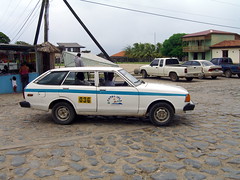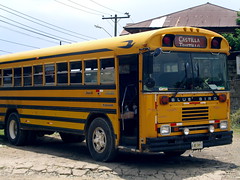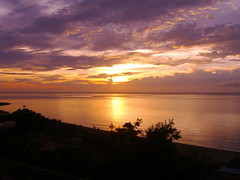How do you travel from place to place? Do you do lots of walking or are there buses?
Here in Trujillo, I walk everywhere. I do have a bike, but the tires are flat and the only pumps sold here in Trujillo are useless pieces of junk that don't even push out enough air to inflate a beach ball. I'll eventually get to Ceiba and buy a real pump, and then I might use the bike a bit. But even then I'll still probably walk everywhere.
If I'm tired or carrying a bunch of stuff or just feeling lazy, I'll take a cab. Taxi cabs are all over every city in Honduras. They're white with a colored stripe (the stripe in Trujillo is light blue) and it costs 15 Lempiras (about 80 cents) to go anywhere in town.
For longer trips, there's the Honduran public transportation system. How to describe it? In a sound bite, I would call it "miraculously effective." Effective because you can get from almost any part of the country to any other part of the country (Gracias a Dios excepted) for a reasonable price and in a reasonable amount of time. Miraculous because Honduran transportation is the most haphazard, slipshod, run-down, disorganized and utterly chaotic "system" I've ever seen. It makes second-class Mexican buses look like luxury cruises on wheels. Yet somehow, it works.
There isn't one or just a few bus companies. There are dozens, if not hundreds, in Honduras. Each one operates on a small number of routes, and often has it's own stop in the cities and major towns it passes through. Trujillo actually has a bus terminal, but many cities don't, and where you catch the bus depends on which company you're riding with. Despite these complete decentralization, it's actually pretty easy to get from place to place. All buses fall under one of the following categories:
Directo - "Directo" means direct. But in reality, "directo" means slightly fewer stops. The only truly direct buses are the Hedman Alas buses, which are extremely expensive and don't really count as Honduran transportation because the average Honduran could never afford them. Directo busses usually only stop at major towns/cities and don't enter the city, instead pausing a few minutes on the shoulder of the highway. And they usually don't stop in the middle of the road to pick up passengers. On average, directos are a little bit newer, a little bit more comfortable (the seat might recline, and there might be legroom for someone taller than 5'6").
Semi-Directo - Meaning "semi-direct," these buses make more stops, for longer, and will usually enter the city, crawling along unpaved roads, letting passengers on and off. They will also pick up passengers anywhere on the road. People just stick out their thumb or wave their hands to get the bus to stop. Bus quality is pretty low. Usually these are old school buses, designed for elementary- or middle-schoolers. That means no legspace. The tires are usually bald and the engine sounds like it's about to fall out of the chassis.
Indirecto - I've heard talk of these, but I'm not sure if in practice there is a difference between Semi-Directo and Indirecto. Indirectos ("indirect") are probably just like semi-directos, just with even more stops and even worse bus maintenance. And it's hard to imagine semi-directos being substantially worse. And who would want to advertise being an indirecto?
Rapidito - These are usually large vans or minibuses. They run a fixed route, usually connecting two or more neighboring towns. They pick up anyone who flags them down, and drop them off wherever they ask. They usually seat around 10 - 15, with little standing room. That doesn't stop them from cramming in as many people as possible, which is especially uncomfortable when you're a 5'10" gringo forced to bow under the 5'3" ceiling and stare at either the breastfeeding mother who has somehow fit herself, her baby and her two other kids onto a single seat or at the machete-carrying toothless campesino who's missing 3 fingers.
Urbano - Urbano ("Urban") buses follow a fixed route through a large town or city. There's an Urbano here in Trujillo that goes through most of the major neighborhoods. It's a clunky old schoolbus, but at least the trip is short.
All of these buses run with a driver and an ayudante (helper). The ayudante announces stops and walks the aisle from time to time checking tickets and collecting fares. These different transportation options form a pretty good transportation network. But a critical ingredient that keeps everything working (relatively) smoothly is the jalón. Hitchhiking. I've heard of PCVs who have jaloned hundreds of kilometers because they missed a bus. And it is often time the only way to get around rural areas.
There's a whole system to jaloning, with hand gestures and etiquette. The jaloner starts by standing on the road, sticking his thumb out at passing cars. When a car passes, the driver who doesn't stop will usually respond with one of three hand gestures (instead of just blowing past without acknowledging the jaloner). All five fingers bunched together and pointed upwards means the car is packed and there's no room. Pointing ahead in an arcing motion means sorry, I'm just going alli no mas (there no more). Wagging your index finger side to side just means no.
If a driver decides to pick up a jaloner, he'll pull off to the side of the road and the jaloner will come up to the window and state his destination. The driver will say where he's going and where he'll drop of the rider (if he's not going all the way). The jaloner jumps in (usually into the back of the pickup truck), and holds on for the ride. Upon reaching the dropoff point, the jaloner jumps out and thanks the driver. For longer jalons, the jaloner may offer to pay some money for gas.






